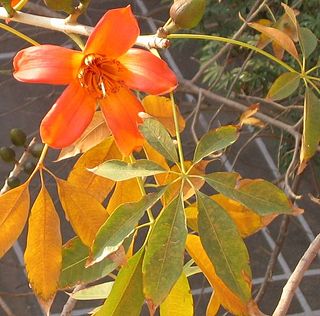
Bombacaceae were long recognised as a family of flowering plants or Angiospermae. The family name was based on the type genus Bombax. As is true for many botanical names, circumscription and status of the taxon has varied with taxonomic point of view, and currently the preference is to transfer most of the erstwhile family Bombacaceae to the subfamily Bombacoideae within the family Malvaceae in the order Malvales. The rest of the family were transferred to other taxa, notably the new family Durionaceae. Irrespective of current taxonomic status, many of the species originally included in the Bombacaceae are of considerable ecological, historical, horticultural, and economic importance, such as balsa, kapok, baobab and durian.

Manilkara is a genus of trees in the family Sapotaceae. They are widespread in tropical and semitropical locations, in Africa, Madagascar, Asia, Australia, and Latin America, as well as various islands in the Pacific and in the Caribbean. A close relative is the genus Pouteria.
Dodecastigma is a genus of plants under the family Euphorbiaceae first described as a genus in 1932. It is native to northern South America.
- Dodecastigma amazonicumDucke - Amazonas State in Brazil
- Dodecastigma integrifolium(Lanj.) Lanj. & Sandwith - French Guiana, Guyana, N Brazil
- Dodecastigma uleanum(Pax & K.Hoffm.) G.L.Webster - Amazonas, Amapá

Sterculia is a genus of flowering plants in the mallow family, Malvaceae: subfamily Sterculioideae. Members of the genus are colloquially known as tropical chestnuts. Sterculia may be monoecious or dioecious, and its flowers unisexual or bisexual.

Dipteryx is a genus containing a number of species of large trees and possibly shrubs. It belongs to the "papilionoid" subfamily – Faboideae – of the family Fabaceae. This genus is native to South and Central America and the Caribbean. Formerly, the related genus Taralea was included in Dipteryx.

Peltogyne, commonly known as purpleheart, violet wood, amaranth and other local names is a genus of 23 species of flowering plants in the family Fabaceae; native to tropical rainforests of Central and South America; from Guerrero, Mexico, through Central America, and as far as south-eastern Brazil.

Parkia is a genus of flowering plants in the family Fabaceae. It belongs to the mimosoid clade of the subfamily Caesalpinioideae. Several species are known as African locust bean.
Adolpho Ducke, , was a notable entomologist, botanist and ethnographer specializing in Amazonia. According to family records, he was an ethnic German with roots in Trieste Austro-Hungary. German was his first language; that is, the German commonly spoken in Trieste in the 19th century. Most of his books were written in German.
Astronium lecointei is a timber tree, which is native to Brazil.
Antrocaryon amazonicum is a species of tree in the cashew family, Anacardiaceae. It is native to Brazil.

Andira is a genus of flowering plants in the legume family, Fabaceae. It is distributed in the tropical Americas, except for A. inermis, which also occurs in Africa. It was formerly assigned to the tribe Dalbergieae, but recent molecular phylogenetic evidence has placed it in a unique clade named the Andira clade.

Dipteryx charapilla is a little-known species of flowering plant in the family Fabaceae, a large to mid-sized tree growing along rivers in the rainforests of Brazil. and Peru.

Macrolobium is a legume genus in the subfamily Detarioideae. It is a tropical genus with about 80 species. Half occur in Brazil, where they are common in the floodplains of the Amazonian Basin. Members of the genus are used as ornamentals and for their wood.

Ormosia is a genus of legumes. The more than 100 living species, mostly trees or large shrubs, are distributed throughout the tropical regions of the world, some extending into temperate zones, especially in East Asia. A few species are threatened by habitat destruction, while the Hainan ormosia is probably extinct already.

Swartzia is a genus of flowering plants in the family Fabaceae. It was named in honor of Swedish botanist Olof Swartz and contains about 200 species. Swartzia is restricted in its geographical distribution to the New World Tropics, where it occurs primarily in lowland rainforests, but also in savannas, pre-montane forests, and tropical dry forests. While it can be found throughout the wet lowlands from Mexico and the Caribbean islands to southern Brazil and Bolivia, Swartzia is most abundant and species-rich in Amazonia, where 10–20 species may co-occur at a single site. The species of Swartzia are mostly trees, ranging from small understory treelets to large canopy emergents. Some species, especially in savannas, are mult-stemmed shrubs.
Naucleopsis is a plant genus in family Moraceae.

Pradosia is a genus of plants in the family Sapotaceae described as a genus in 1872.
Hevea camporum is a species of flowering plant in the genus Hevea, the rubber trees, belonging to the family Euphorbiaceae. It is native to the Amazon basin where it occurs in Amazonas State in northwestern Brazil. Its habitat is dry savannah. In form it is a shrub, rarely taller than 2 m (7 ft) in the wild, though it can grow taller in cultivation.
Aguiaria is a monotypic genus of flowering plants belonging to the family Malvaceae.
Dicranostyles is a genus of flowering plants belonging to the family Convolvulaceae.












